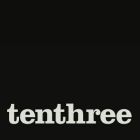
Finely Sliced: Brendan Jenkins on His Musical and Film Influences

Brendan Jenkins has been a steadfast member at the award-winning edit house, tenthree for nearly a decade. With an especially good eye for comedy, textured detail, and a savvy set of vfx skills - he brings a strong mix of creativity and technicality to all projects. Recent collaborations include brands such as Nike, Sports Direct, Axe, Google, John Lewis and Aston Martin. Brendan’s career kick-started in Australia, working on George Miller’s Happy Feet 2 and Mad Max: Fury Road, where he developed a real taste for the edit suite. Working on these films instilled in him a strong passion for film and storytelling which overflows into every project he cuts.
LBB> Why did you get started in editing? And what has the journey been like up until this moment?
Brendan> Mine has definitely not been straight forward, I was always a massive film fan but felt the film industry was so far out of reach. But while studying Fine Art at university in Australia, I was introduced to Final Cut Pro and became instantly obsessed. I spent the rest of my art degree making short films, reading filmmaking books and hassling the film school next door for cameras to borrow. My world opened up after graduation when I was hired as an assistant editor on Happy Feet 2, directed by George Miller. I spent a lot of time as onset editor stage sitting next to George on the motion capture stage, doing rough scene assembles of the motion capture performance. He’s an incredible storyteller and I was like a sponge listening to him. I continued to constantly create in my spare time - cutting music videos, short films and anything else I could get my hands on, which mainly happened all hours of the night. Following HF2, I was sent to the sandy deserts of Namibia where I was on the editorial frontline for George’s next film, Mad Max: Fury Road. Taking on the task of processing hundreds of hours of footage. Dusting myself off I sought out new creative challenges, and this, like a lot of Aussies, led me to London. Long story short, for the last 9 years tenthree has been my creative home.
LBB> The first cut is the deepest: how do you like to start an editing project?
Brendan> Rushes can vary between rigidly storyboarded and free flowing so I always like to stay a little flexible and take any opportunity to adapt my workflow. After my initial select, I’ll do a quick intuitive assemble to get the thread of the story down and feel out the tone. This then leads me into a tighter select. Of course, it’s always important to communicate with the director before getting started. I’ll chat to them and get their thoughts and ideas.
LBB> Non-editors often think of editing just in technical terms but it’s integral to the emotion and mood of a film. How did you develop that side of your craft?
Brendan> You can read a million books on the theory of editing but you learn it all in the cutting room. The more jobs you do, the more you start to understand what’s important - what do I feel when I watch it back, how do I think the audience will respond to humour, narrative or contextually does it actually make sense. An objective pair of fresh eyes over the edit always helps me re-set my perspective as well, as you can get a bit lost in the process.
LBB> How important is an understanding of story and the mechanics of story?
Brendan> This is important for sure. And even more so when you’re restricted by specific broadcast lengths. That’s a skill I’m constantly refining. To tell the story in the clearest and most precise way means that every shot must earn its place in the edit. The reality is that filmmaking is very subjective, and in advertising there are many agendas to consider. You will always receive feedback, and sometimes it may initially feel that it goes against the value of the story you’ve been trying to tell.
LBB> Rhythm and a sense of musicality seem to be intrinsic to good editing (even when it’s a film without actual music) – how do you think about the rhythm side of editing, how do you feel out the beats of a scene or a spot? And do you like to cut to music?
Brendan> I’ve always had a big love for music, and seem to be surrounded by musicians in my life. And definitely sway toward using music to either cut with or just play in the background while I work. But I also often hit the mute button while reviewing to get a sense of the visual rhythm, as in the relationship between flow, performance, and action.
For music videos, it can feel natural and rhythmic to cut to the beat and tempo of the track. An alternate approach that Joao Retorta and I had for Prospa ‘Prayer’ is to invert this idea. We had fast montage leading up to the music drop and then at the height of the chorus where you’d expect the cuts to follow the tempo of the music, we cut to long drawn-out shots, allowing the audience to feel the music and rhythm within the performance.
LBB> Tell us about a recent editing project that involved some interesting creative challenges.
Brendan> I love working on jobs that are quite post heavy. I try to do as much rough vfx in the offline stage as possible. A fun project I recently worked on was for Carlsberg, directed by Martin Aaumund. The protagonist has a sip of beer, then proceeds to fall through an imaginary world representing the different flavours of the beer. The actor was filmed on green screen and most of the world he falls through is 3D animation. We worked hard on timing, animating the motion and scale of the actor. Using the storyboards as background plates, I comped in as many elements as I could to tell the story and give a visual guide of the action that will be created in post. In circumstances like this, that require a lot of imagination, I always find that a decent sound bed is very helpful to get a sense of pace and rhythm.
LBB> How important is your relationship with the director and how do you approach difficult conversations when there is a creative difference of opinion?
Brendan> An ideal time in the edit suite is working hard but also having some good D&M’s on life and finding the ‘same page’ in mood, image and tone.
There’s always going to be conflicting ideas and opinions in such a subjective and personal space. Directors are so close to a job as they’ve lived and envisioned every single frame whilst the editor comes in with a fresh vision. But both sides come with an advantage, it’s within the creative discussions and debates that lead to greater ideas.
LBB> What’s harder to cut around – too much material or not enough? (And why?)
Brendan> Good question. You can never have enough footage. But there is definitely argument for quality over quantity. So I’ll take middle of the road on this one.
LBB> There are so many different platforms for film content now, and even in advertising something can last anything from a few seconds to a couple of hours. As an editor, are you seeing a change in the kind of projects you’re getting from brands and agencies?
Brendan> For this year, whether they are a set of original films or cutdowns, there seems to be a lot of 15sec versions bouncing around.
LBB> Who are your editing heroes and why? What films or spots epitomise good editing for you?
Brendan> Aside from all the big influential editors from cinema, I have to mention a recent film edit that impressed me - Everything, Everywhere, All At Once edited by Paul Rogers. I went into the cinema totally cold on what I was about to experience. Blew my mind. It’s proof that you can create something that is heavily stylised and still retain a strong story with hard hitting drama. And hats off to Paul , who apparently cut this film in his living room during lockdown.
LBB> What plans or projects are you looking forward to?
Brendan> I’ve recently signed with Uppercut in the US. Having already gone across for 2 projects, I’m looking forward to working and learning more from the US market.
LBB> Have you noticed any trends or changes in commercial editing over recent years?
Brendan> Creative transitions such as crash zooms and whips, in camera trickery and mix media is prevalent. Shooting on film is still popular which makes me happy.
LBB> Do you have any tips for young editors starting out right now?
Brendan> Cut everything and anything. Not every job will end up on your reel, but you’ll still learn from each one. It’s a craft that takes time to learn, so trust that the more you do it - the better you’ll be.













